Business Law Report: UK Legal System, Kango, Employment, and Disputes
VerifiedAdded on 2020/11/12
|11
|3251
|359
Report
AI Summary
This report provides a comprehensive overview of business law within the context of the United Kingdom. It begins by outlining the sources of law, differentiating between primary and secondary sources, and explaining the role of government in law-making, including the application of statutory and common law. The report then examines the impact of employment and contract laws on a hypothetical organization, Kango, differentiating between employed and self-employed statuses, with reference to the Pimlico Plumbers v. Smith case. Furthermore, it evaluates various types of business organizations available to Kango and concludes by recommending legal solutions for resolving potential areas of dispute. The report utilizes legal concepts to analyze how the UK legal system affects business operations, employment relationships, and organizational structures, offering insights into legal compliance and dispute resolution strategies.
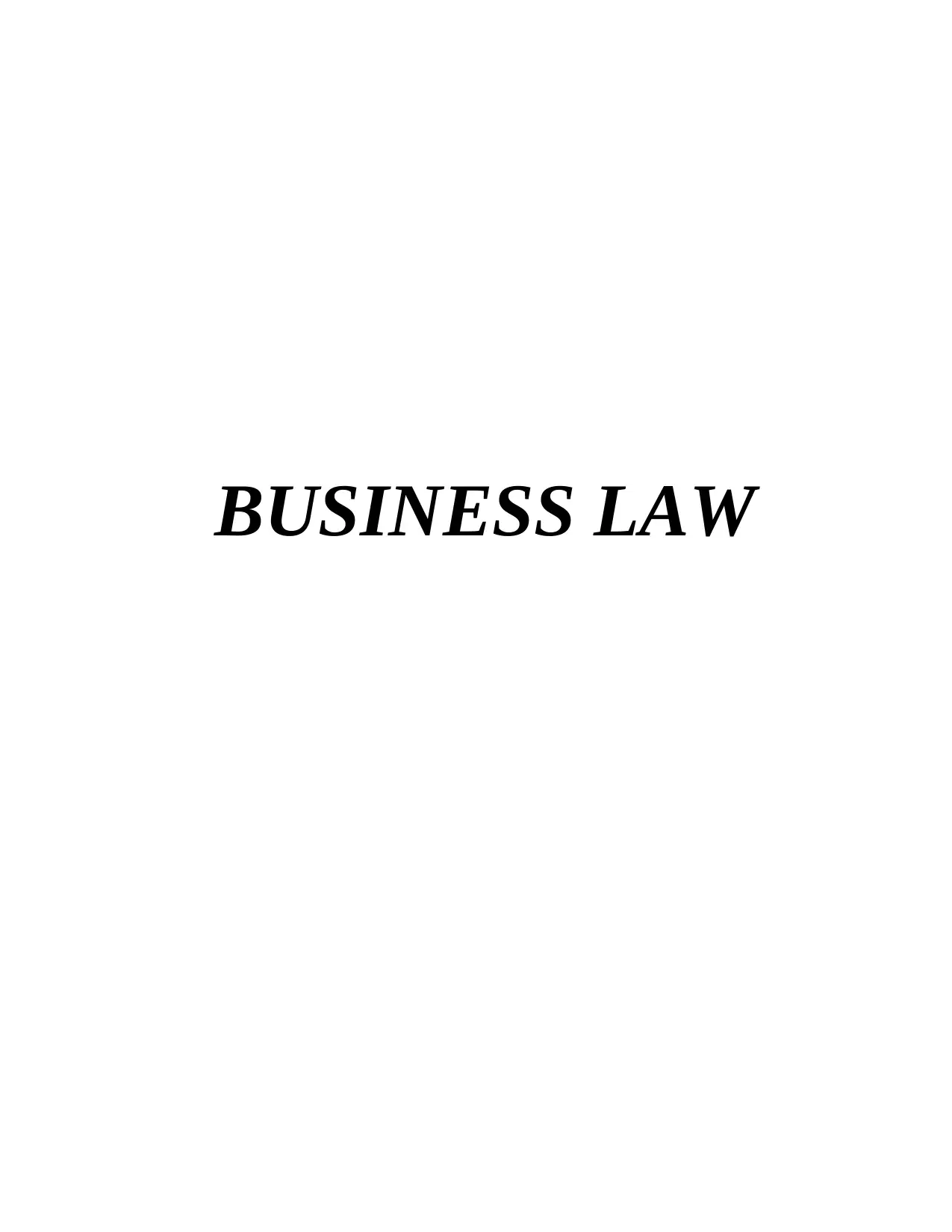
BUSINESS LAW
Paraphrase This Document
Need a fresh take? Get an instant paraphrase of this document with our AI Paraphraser
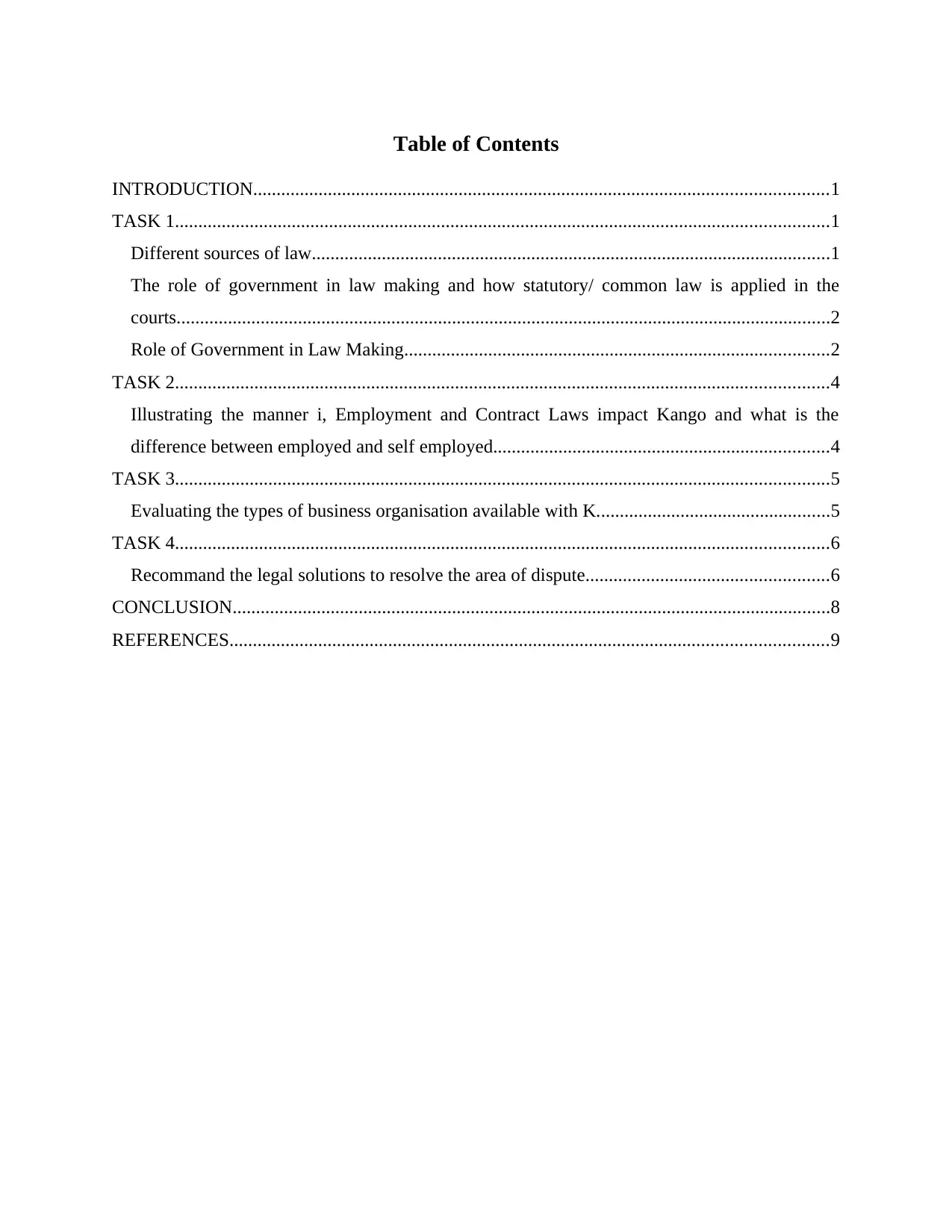
Table of Contents
INTRODUCTION...........................................................................................................................1
TASK 1............................................................................................................................................1
Different sources of law...............................................................................................................1
The role of government in law making and how statutory/ common law is applied in the
courts............................................................................................................................................2
Role of Government in Law Making...........................................................................................2
TASK 2............................................................................................................................................4
Illustrating the manner i, Employment and Contract Laws impact Kango and what is the
difference between employed and self employed........................................................................4
TASK 3............................................................................................................................................5
Evaluating the types of business organisation available with K..................................................5
TASK 4............................................................................................................................................6
Recommand the legal solutions to resolve the area of dispute....................................................6
CONCLUSION................................................................................................................................8
REFERENCES................................................................................................................................9
INTRODUCTION...........................................................................................................................1
TASK 1............................................................................................................................................1
Different sources of law...............................................................................................................1
The role of government in law making and how statutory/ common law is applied in the
courts............................................................................................................................................2
Role of Government in Law Making...........................................................................................2
TASK 2............................................................................................................................................4
Illustrating the manner i, Employment and Contract Laws impact Kango and what is the
difference between employed and self employed........................................................................4
TASK 3............................................................................................................................................5
Evaluating the types of business organisation available with K..................................................5
TASK 4............................................................................................................................................6
Recommand the legal solutions to resolve the area of dispute....................................................6
CONCLUSION................................................................................................................................8
REFERENCES................................................................................................................................9
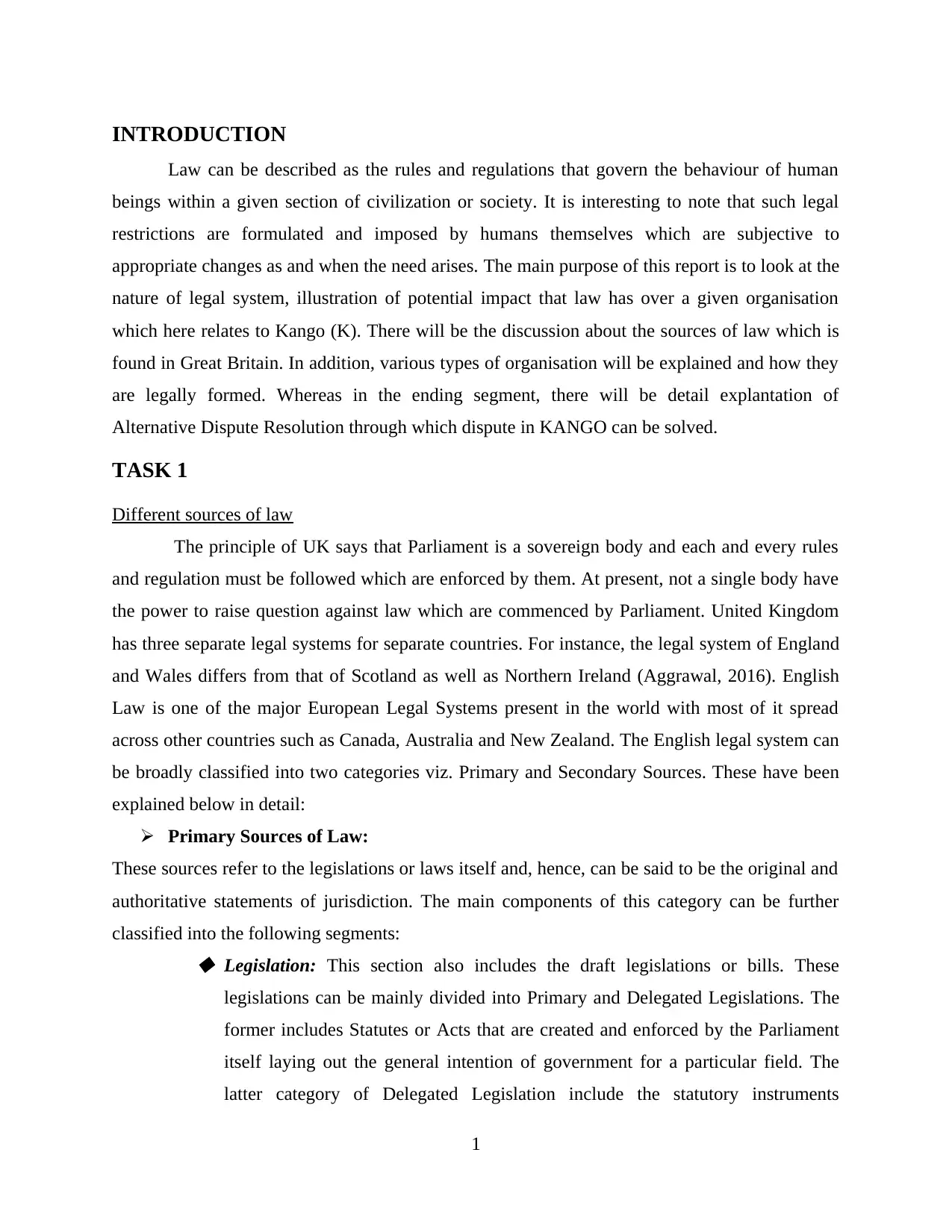
INTRODUCTION
Law can be described as the rules and regulations that govern the behaviour of human
beings within a given section of civilization or society. It is interesting to note that such legal
restrictions are formulated and imposed by humans themselves which are subjective to
appropriate changes as and when the need arises. The main purpose of this report is to look at the
nature of legal system, illustration of potential impact that law has over a given organisation
which here relates to Kango (K). There will be the discussion about the sources of law which is
found in Great Britain. In addition, various types of organisation will be explained and how they
are legally formed. Whereas in the ending segment, there will be detail explantation of
Alternative Dispute Resolution through which dispute in KANGO can be solved.
TASK 1
Different sources of law
The principle of UK says that Parliament is a sovereign body and each and every rules
and regulation must be followed which are enforced by them. At present, not a single body have
the power to raise question against law which are commenced by Parliament. United Kingdom
has three separate legal systems for separate countries. For instance, the legal system of England
and Wales differs from that of Scotland as well as Northern Ireland (Aggrawal, 2016). English
Law is one of the major European Legal Systems present in the world with most of it spread
across other countries such as Canada, Australia and New Zealand. The English legal system can
be broadly classified into two categories viz. Primary and Secondary Sources. These have been
explained below in detail:
Primary Sources of Law:
These sources refer to the legislations or laws itself and, hence, can be said to be the original and
authoritative statements of jurisdiction. The main components of this category can be further
classified into the following segments:
Legislation: This section also includes the draft legislations or bills. These
legislations can be mainly divided into Primary and Delegated Legislations. The
former includes Statutes or Acts that are created and enforced by the Parliament
itself laying out the general intention of government for a particular field. The
latter category of Delegated Legislation include the statutory instruments
1
Law can be described as the rules and regulations that govern the behaviour of human
beings within a given section of civilization or society. It is interesting to note that such legal
restrictions are formulated and imposed by humans themselves which are subjective to
appropriate changes as and when the need arises. The main purpose of this report is to look at the
nature of legal system, illustration of potential impact that law has over a given organisation
which here relates to Kango (K). There will be the discussion about the sources of law which is
found in Great Britain. In addition, various types of organisation will be explained and how they
are legally formed. Whereas in the ending segment, there will be detail explantation of
Alternative Dispute Resolution through which dispute in KANGO can be solved.
TASK 1
Different sources of law
The principle of UK says that Parliament is a sovereign body and each and every rules
and regulation must be followed which are enforced by them. At present, not a single body have
the power to raise question against law which are commenced by Parliament. United Kingdom
has three separate legal systems for separate countries. For instance, the legal system of England
and Wales differs from that of Scotland as well as Northern Ireland (Aggrawal, 2016). English
Law is one of the major European Legal Systems present in the world with most of it spread
across other countries such as Canada, Australia and New Zealand. The English legal system can
be broadly classified into two categories viz. Primary and Secondary Sources. These have been
explained below in detail:
Primary Sources of Law:
These sources refer to the legislations or laws itself and, hence, can be said to be the original and
authoritative statements of jurisdiction. The main components of this category can be further
classified into the following segments:
Legislation: This section also includes the draft legislations or bills. These
legislations can be mainly divided into Primary and Delegated Legislations. The
former includes Statutes or Acts that are created and enforced by the Parliament
itself laying out the general intention of government for a particular field. The
latter category of Delegated Legislation include the statutory instruments
1
⊘ This is a preview!⊘
Do you want full access?
Subscribe today to unlock all pages.

Trusted by 1+ million students worldwide
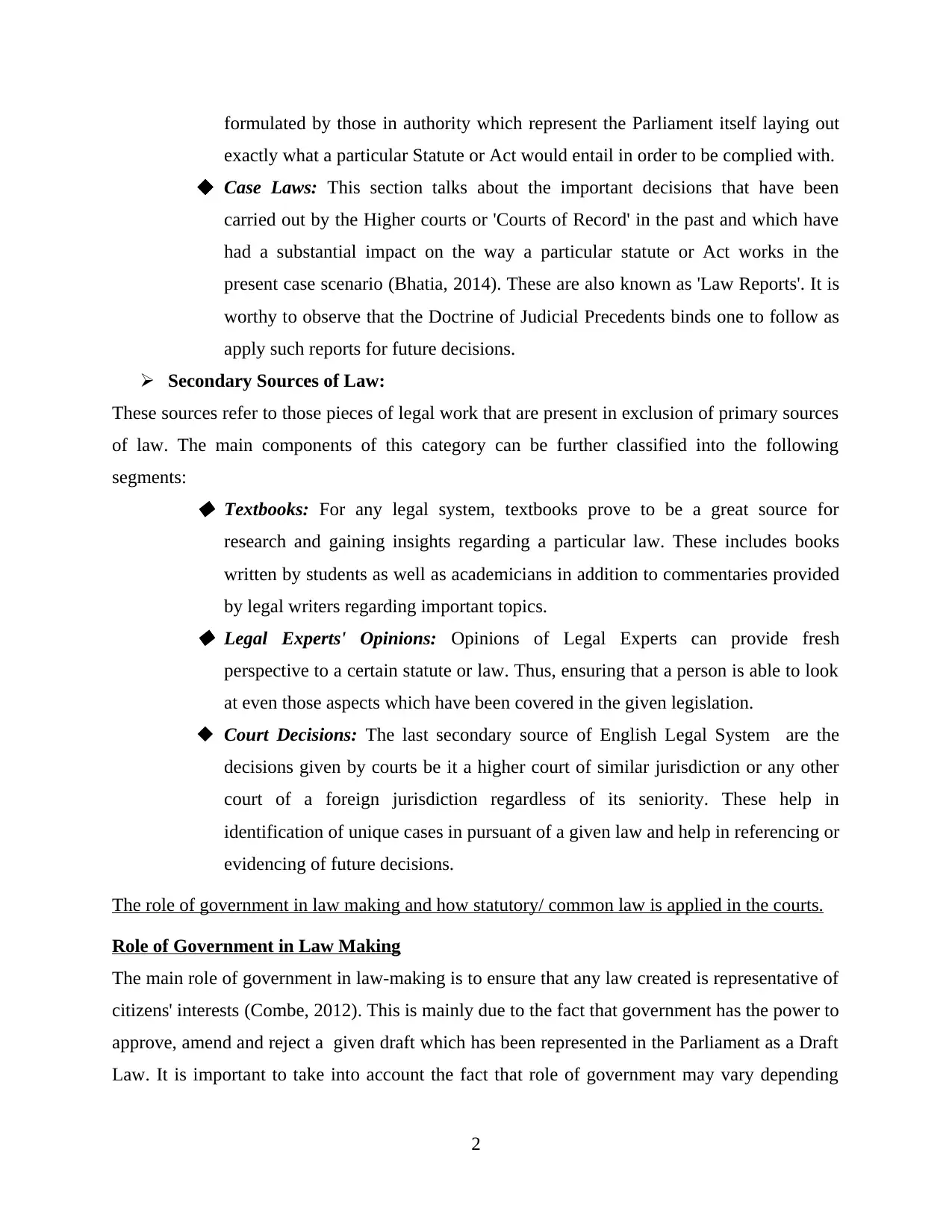
formulated by those in authority which represent the Parliament itself laying out
exactly what a particular Statute or Act would entail in order to be complied with.
Case Laws: This section talks about the important decisions that have been
carried out by the Higher courts or 'Courts of Record' in the past and which have
had a substantial impact on the way a particular statute or Act works in the
present case scenario (Bhatia, 2014). These are also known as 'Law Reports'. It is
worthy to observe that the Doctrine of Judicial Precedents binds one to follow as
apply such reports for future decisions.
Secondary Sources of Law:
These sources refer to those pieces of legal work that are present in exclusion of primary sources
of law. The main components of this category can be further classified into the following
segments:
Textbooks: For any legal system, textbooks prove to be a great source for
research and gaining insights regarding a particular law. These includes books
written by students as well as academicians in addition to commentaries provided
by legal writers regarding important topics.
Legal Experts' Opinions: Opinions of Legal Experts can provide fresh
perspective to a certain statute or law. Thus, ensuring that a person is able to look
at even those aspects which have been covered in the given legislation.
Court Decisions: The last secondary source of English Legal System are the
decisions given by courts be it a higher court of similar jurisdiction or any other
court of a foreign jurisdiction regardless of its seniority. These help in
identification of unique cases in pursuant of a given law and help in referencing or
evidencing of future decisions.
The role of government in law making and how statutory/ common law is applied in the courts.
Role of Government in Law Making
The main role of government in law-making is to ensure that any law created is representative of
citizens' interests (Combe, 2012). This is mainly due to the fact that government has the power to
approve, amend and reject a given draft which has been represented in the Parliament as a Draft
Law. It is important to take into account the fact that role of government may vary depending
2
exactly what a particular Statute or Act would entail in order to be complied with.
Case Laws: This section talks about the important decisions that have been
carried out by the Higher courts or 'Courts of Record' in the past and which have
had a substantial impact on the way a particular statute or Act works in the
present case scenario (Bhatia, 2014). These are also known as 'Law Reports'. It is
worthy to observe that the Doctrine of Judicial Precedents binds one to follow as
apply such reports for future decisions.
Secondary Sources of Law:
These sources refer to those pieces of legal work that are present in exclusion of primary sources
of law. The main components of this category can be further classified into the following
segments:
Textbooks: For any legal system, textbooks prove to be a great source for
research and gaining insights regarding a particular law. These includes books
written by students as well as academicians in addition to commentaries provided
by legal writers regarding important topics.
Legal Experts' Opinions: Opinions of Legal Experts can provide fresh
perspective to a certain statute or law. Thus, ensuring that a person is able to look
at even those aspects which have been covered in the given legislation.
Court Decisions: The last secondary source of English Legal System are the
decisions given by courts be it a higher court of similar jurisdiction or any other
court of a foreign jurisdiction regardless of its seniority. These help in
identification of unique cases in pursuant of a given law and help in referencing or
evidencing of future decisions.
The role of government in law making and how statutory/ common law is applied in the courts.
Role of Government in Law Making
The main role of government in law-making is to ensure that any law created is representative of
citizens' interests (Combe, 2012). This is mainly due to the fact that government has the power to
approve, amend and reject a given draft which has been represented in the Parliament as a Draft
Law. It is important to take into account the fact that role of government may vary depending
2
Paraphrase This Document
Need a fresh take? Get an instant paraphrase of this document with our AI Paraphraser
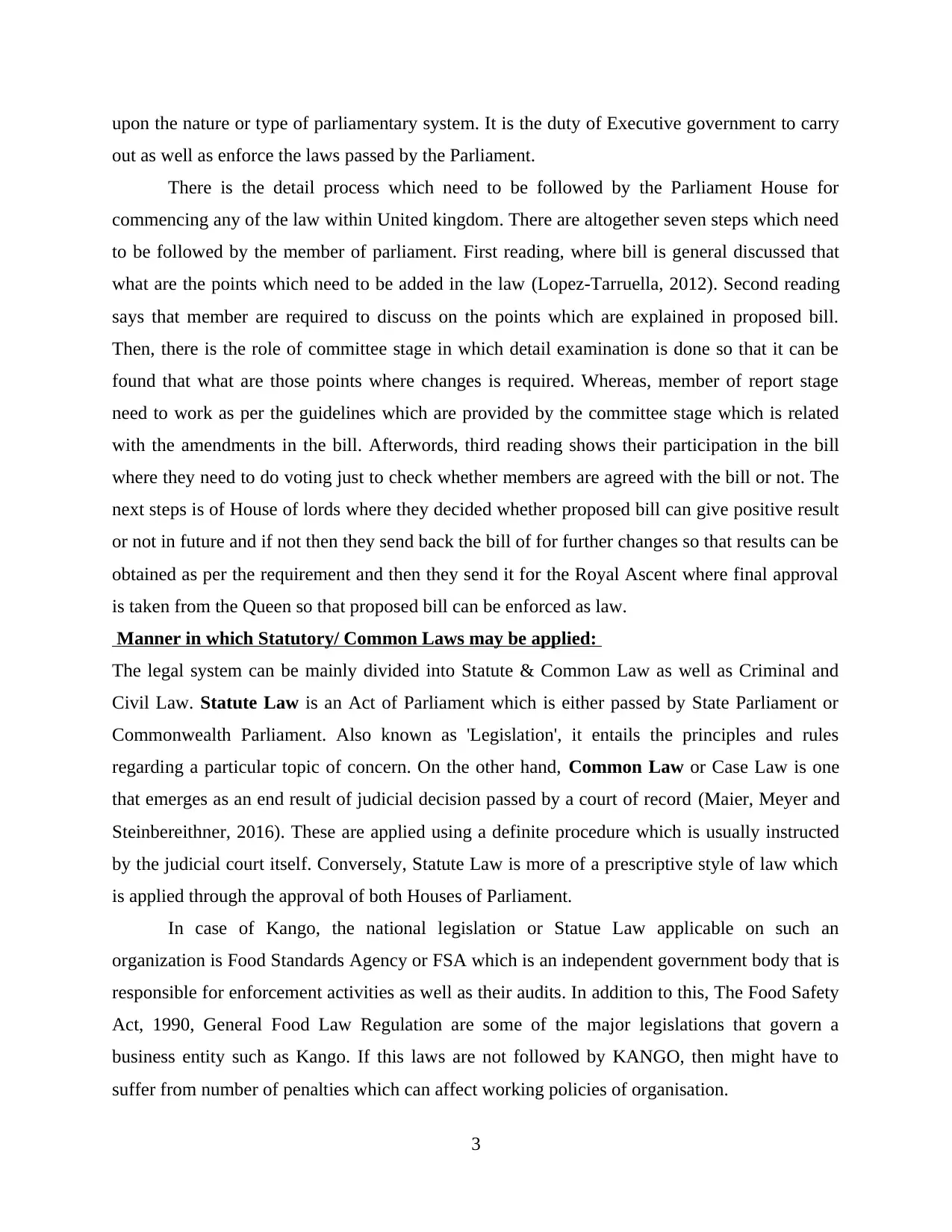
upon the nature or type of parliamentary system. It is the duty of Executive government to carry
out as well as enforce the laws passed by the Parliament.
There is the detail process which need to be followed by the Parliament House for
commencing any of the law within United kingdom. There are altogether seven steps which need
to be followed by the member of parliament. First reading, where bill is general discussed that
what are the points which need to be added in the law (Lopez-Tarruella, 2012). Second reading
says that member are required to discuss on the points which are explained in proposed bill.
Then, there is the role of committee stage in which detail examination is done so that it can be
found that what are those points where changes is required. Whereas, member of report stage
need to work as per the guidelines which are provided by the committee stage which is related
with the amendments in the bill. Afterwords, third reading shows their participation in the bill
where they need to do voting just to check whether members are agreed with the bill or not. The
next steps is of House of lords where they decided whether proposed bill can give positive result
or not in future and if not then they send back the bill of for further changes so that results can be
obtained as per the requirement and then they send it for the Royal Ascent where final approval
is taken from the Queen so that proposed bill can be enforced as law.
Manner in which Statutory/ Common Laws may be applied:
The legal system can be mainly divided into Statute & Common Law as well as Criminal and
Civil Law. Statute Law is an Act of Parliament which is either passed by State Parliament or
Commonwealth Parliament. Also known as 'Legislation', it entails the principles and rules
regarding a particular topic of concern. On the other hand, Common Law or Case Law is one
that emerges as an end result of judicial decision passed by a court of record (Maier, Meyer and
Steinbereithner, 2016). These are applied using a definite procedure which is usually instructed
by the judicial court itself. Conversely, Statute Law is more of a prescriptive style of law which
is applied through the approval of both Houses of Parliament.
In case of Kango, the national legislation or Statue Law applicable on such an
organization is Food Standards Agency or FSA which is an independent government body that is
responsible for enforcement activities as well as their audits. In addition to this, The Food Safety
Act, 1990, General Food Law Regulation are some of the major legislations that govern a
business entity such as Kango. If this laws are not followed by KANGO, then might have to
suffer from number of penalties which can affect working policies of organisation.
3
out as well as enforce the laws passed by the Parliament.
There is the detail process which need to be followed by the Parliament House for
commencing any of the law within United kingdom. There are altogether seven steps which need
to be followed by the member of parliament. First reading, where bill is general discussed that
what are the points which need to be added in the law (Lopez-Tarruella, 2012). Second reading
says that member are required to discuss on the points which are explained in proposed bill.
Then, there is the role of committee stage in which detail examination is done so that it can be
found that what are those points where changes is required. Whereas, member of report stage
need to work as per the guidelines which are provided by the committee stage which is related
with the amendments in the bill. Afterwords, third reading shows their participation in the bill
where they need to do voting just to check whether members are agreed with the bill or not. The
next steps is of House of lords where they decided whether proposed bill can give positive result
or not in future and if not then they send back the bill of for further changes so that results can be
obtained as per the requirement and then they send it for the Royal Ascent where final approval
is taken from the Queen so that proposed bill can be enforced as law.
Manner in which Statutory/ Common Laws may be applied:
The legal system can be mainly divided into Statute & Common Law as well as Criminal and
Civil Law. Statute Law is an Act of Parliament which is either passed by State Parliament or
Commonwealth Parliament. Also known as 'Legislation', it entails the principles and rules
regarding a particular topic of concern. On the other hand, Common Law or Case Law is one
that emerges as an end result of judicial decision passed by a court of record (Maier, Meyer and
Steinbereithner, 2016). These are applied using a definite procedure which is usually instructed
by the judicial court itself. Conversely, Statute Law is more of a prescriptive style of law which
is applied through the approval of both Houses of Parliament.
In case of Kango, the national legislation or Statue Law applicable on such an
organization is Food Standards Agency or FSA which is an independent government body that is
responsible for enforcement activities as well as their audits. In addition to this, The Food Safety
Act, 1990, General Food Law Regulation are some of the major legislations that govern a
business entity such as Kango. If this laws are not followed by KANGO, then might have to
suffer from number of penalties which can affect working policies of organisation.
3
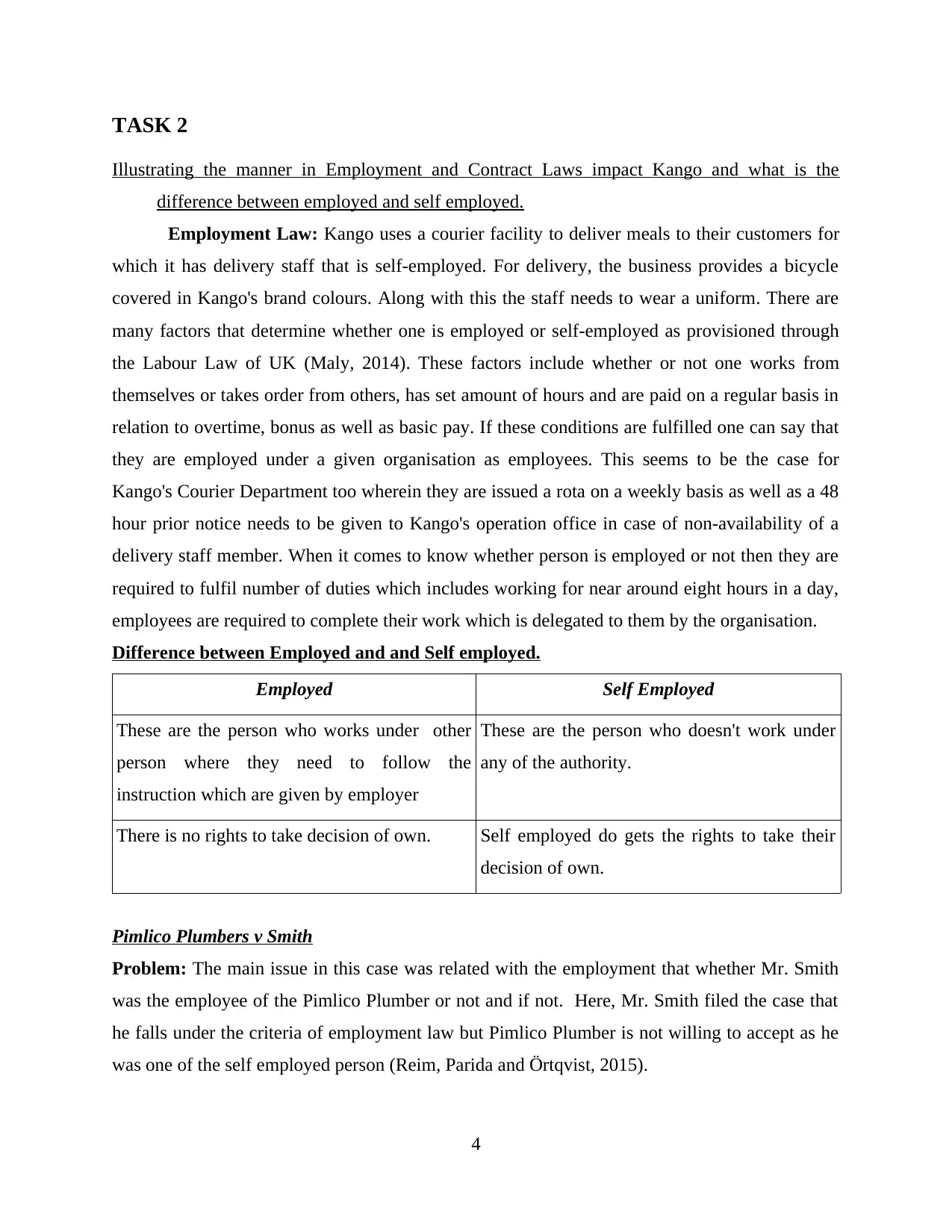
TASK 2
Illustrating the manner in Employment and Contract Laws impact Kango and what is the
difference between employed and self employed.
Employment Law: Kango uses a courier facility to deliver meals to their customers for
which it has delivery staff that is self-employed. For delivery, the business provides a bicycle
covered in Kango's brand colours. Along with this the staff needs to wear a uniform. There are
many factors that determine whether one is employed or self-employed as provisioned through
the Labour Law of UK (Maly, 2014). These factors include whether or not one works from
themselves or takes order from others, has set amount of hours and are paid on a regular basis in
relation to overtime, bonus as well as basic pay. If these conditions are fulfilled one can say that
they are employed under a given organisation as employees. This seems to be the case for
Kango's Courier Department too wherein they are issued a rota on a weekly basis as well as a 48
hour prior notice needs to be given to Kango's operation office in case of non-availability of a
delivery staff member. When it comes to know whether person is employed or not then they are
required to fulfil number of duties which includes working for near around eight hours in a day,
employees are required to complete their work which is delegated to them by the organisation.
Difference between Employed and and Self employed.
Employed Self Employed
These are the person who works under other
person where they need to follow the
instruction which are given by employer
These are the person who doesn't work under
any of the authority.
There is no rights to take decision of own. Self employed do gets the rights to take their
decision of own.
Pimlico Plumbers v Smith
Problem: The main issue in this case was related with the employment that whether Mr. Smith
was the employee of the Pimlico Plumber or not and if not. Here, Mr. Smith filed the case that
he falls under the criteria of employment law but Pimlico Plumber is not willing to accept as he
was one of the self employed person (Reim, Parida and Örtqvist, 2015).
4
Illustrating the manner in Employment and Contract Laws impact Kango and what is the
difference between employed and self employed.
Employment Law: Kango uses a courier facility to deliver meals to their customers for
which it has delivery staff that is self-employed. For delivery, the business provides a bicycle
covered in Kango's brand colours. Along with this the staff needs to wear a uniform. There are
many factors that determine whether one is employed or self-employed as provisioned through
the Labour Law of UK (Maly, 2014). These factors include whether or not one works from
themselves or takes order from others, has set amount of hours and are paid on a regular basis in
relation to overtime, bonus as well as basic pay. If these conditions are fulfilled one can say that
they are employed under a given organisation as employees. This seems to be the case for
Kango's Courier Department too wherein they are issued a rota on a weekly basis as well as a 48
hour prior notice needs to be given to Kango's operation office in case of non-availability of a
delivery staff member. When it comes to know whether person is employed or not then they are
required to fulfil number of duties which includes working for near around eight hours in a day,
employees are required to complete their work which is delegated to them by the organisation.
Difference between Employed and and Self employed.
Employed Self Employed
These are the person who works under other
person where they need to follow the
instruction which are given by employer
These are the person who doesn't work under
any of the authority.
There is no rights to take decision of own. Self employed do gets the rights to take their
decision of own.
Pimlico Plumbers v Smith
Problem: The main issue in this case was related with the employment that whether Mr. Smith
was the employee of the Pimlico Plumber or not and if not. Here, Mr. Smith filed the case that
he falls under the criteria of employment law but Pimlico Plumber is not willing to accept as he
was one of the self employed person (Reim, Parida and Örtqvist, 2015).
4
⊘ This is a preview!⊘
Do you want full access?
Subscribe today to unlock all pages.

Trusted by 1+ million students worldwide
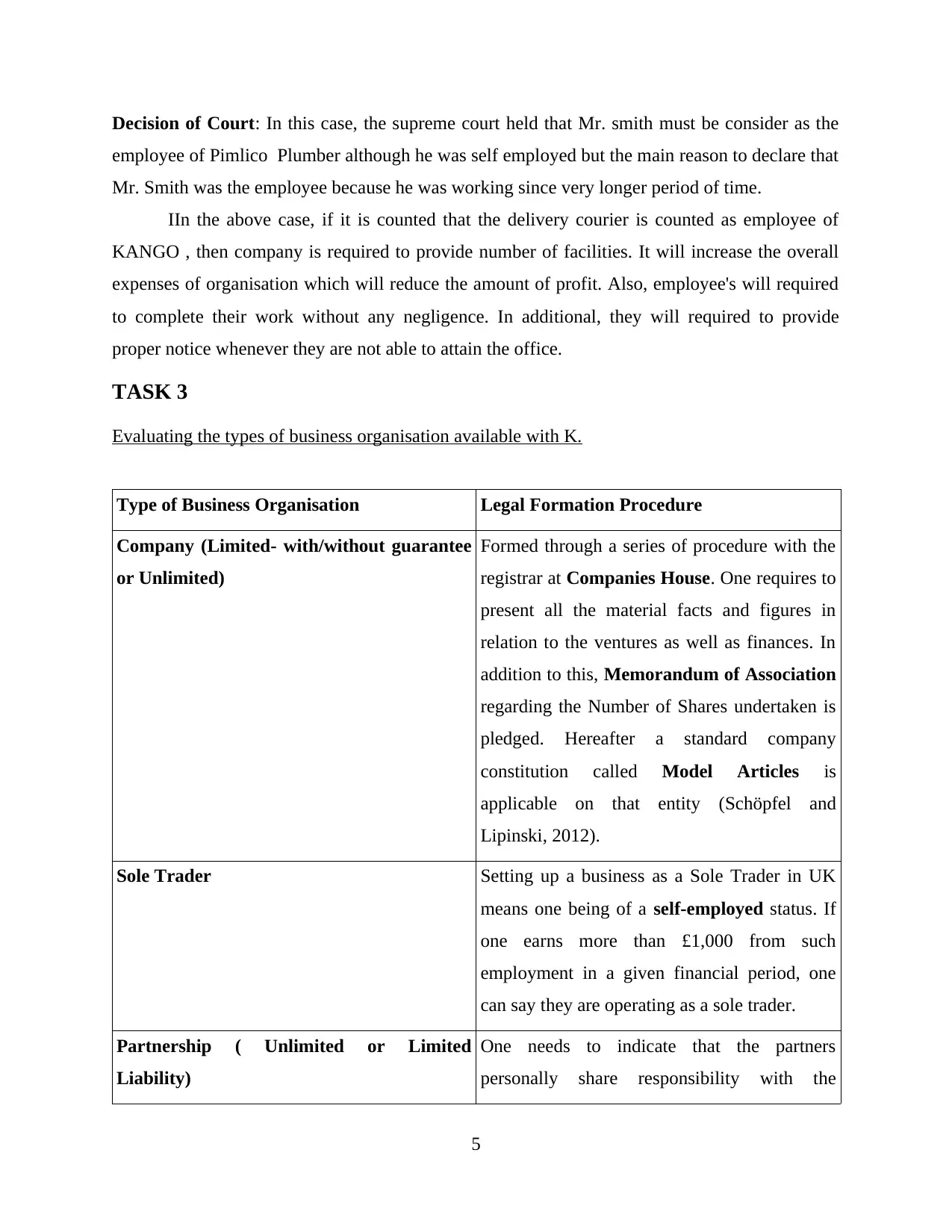
Decision of Court: In this case, the supreme court held that Mr. smith must be consider as the
employee of Pimlico Plumber although he was self employed but the main reason to declare that
Mr. Smith was the employee because he was working since very longer period of time.
IIn the above case, if it is counted that the delivery courier is counted as employee of
KANGO , then company is required to provide number of facilities. It will increase the overall
expenses of organisation which will reduce the amount of profit. Also, employee's will required
to complete their work without any negligence. In additional, they will required to provide
proper notice whenever they are not able to attain the office.
TASK 3
Evaluating the types of business organisation available with K.
Type of Business Organisation Legal Formation Procedure
Company (Limited- with/without guarantee
or Unlimited)
Formed through a series of procedure with the
registrar at Companies House. One requires to
present all the material facts and figures in
relation to the ventures as well as finances. In
addition to this, Memorandum of Association
regarding the Number of Shares undertaken is
pledged. Hereafter a standard company
constitution called Model Articles is
applicable on that entity (Schöpfel and
Lipinski, 2012).
Sole Trader Setting up a business as a Sole Trader in UK
means one being of a self-employed status. If
one earns more than £1,000 from such
employment in a given financial period, one
can say they are operating as a sole trader.
Partnership ( Unlimited or Limited
Liability)
One needs to indicate that the partners
personally share responsibility with the
5
employee of Pimlico Plumber although he was self employed but the main reason to declare that
Mr. Smith was the employee because he was working since very longer period of time.
IIn the above case, if it is counted that the delivery courier is counted as employee of
KANGO , then company is required to provide number of facilities. It will increase the overall
expenses of organisation which will reduce the amount of profit. Also, employee's will required
to complete their work without any negligence. In additional, they will required to provide
proper notice whenever they are not able to attain the office.
TASK 3
Evaluating the types of business organisation available with K.
Type of Business Organisation Legal Formation Procedure
Company (Limited- with/without guarantee
or Unlimited)
Formed through a series of procedure with the
registrar at Companies House. One requires to
present all the material facts and figures in
relation to the ventures as well as finances. In
addition to this, Memorandum of Association
regarding the Number of Shares undertaken is
pledged. Hereafter a standard company
constitution called Model Articles is
applicable on that entity (Schöpfel and
Lipinski, 2012).
Sole Trader Setting up a business as a Sole Trader in UK
means one being of a self-employed status. If
one earns more than £1,000 from such
employment in a given financial period, one
can say they are operating as a sole trader.
Partnership ( Unlimited or Limited
Liability)
One needs to indicate that the partners
personally share responsibility with the
5
Paraphrase This Document
Need a fresh take? Get an instant paraphrase of this document with our AI Paraphraser
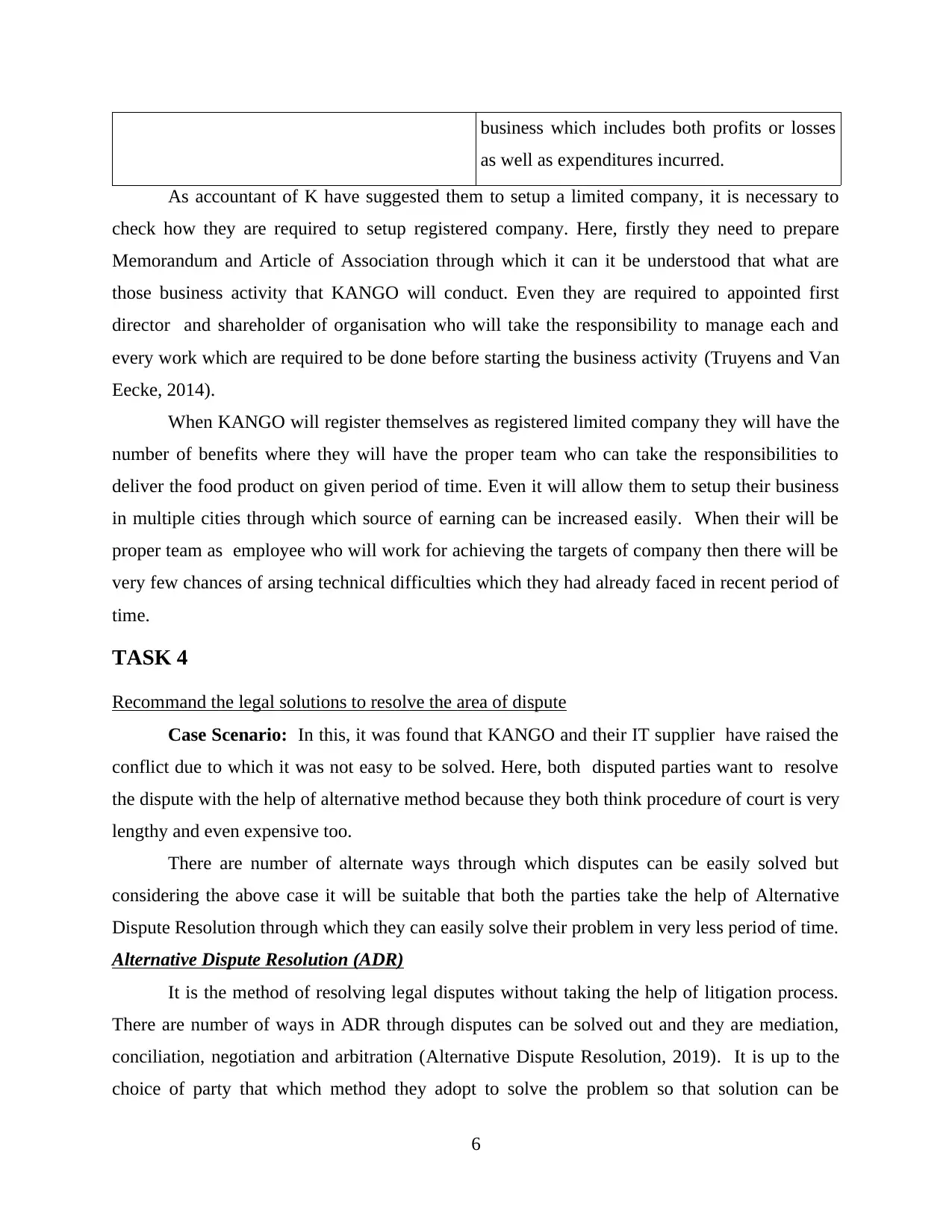
business which includes both profits or losses
as well as expenditures incurred.
As accountant of K have suggested them to setup a limited company, it is necessary to
check how they are required to setup registered company. Here, firstly they need to prepare
Memorandum and Article of Association through which it can it be understood that what are
those business activity that KANGO will conduct. Even they are required to appointed first
director and shareholder of organisation who will take the responsibility to manage each and
every work which are required to be done before starting the business activity (Truyens and Van
Eecke, 2014).
When KANGO will register themselves as registered limited company they will have the
number of benefits where they will have the proper team who can take the responsibilities to
deliver the food product on given period of time. Even it will allow them to setup their business
in multiple cities through which source of earning can be increased easily. When their will be
proper team as employee who will work for achieving the targets of company then there will be
very few chances of arsing technical difficulties which they had already faced in recent period of
time.
TASK 4
Recommand the legal solutions to resolve the area of dispute
Case Scenario: In this, it was found that KANGO and their IT supplier have raised the
conflict due to which it was not easy to be solved. Here, both disputed parties want to resolve
the dispute with the help of alternative method because they both think procedure of court is very
lengthy and even expensive too.
There are number of alternate ways through which disputes can be easily solved but
considering the above case it will be suitable that both the parties take the help of Alternative
Dispute Resolution through which they can easily solve their problem in very less period of time.
Alternative Dispute Resolution (ADR)
It is the method of resolving legal disputes without taking the help of litigation process.
There are number of ways in ADR through disputes can be solved out and they are mediation,
conciliation, negotiation and arbitration (Alternative Dispute Resolution, 2019). It is up to the
choice of party that which method they adopt to solve the problem so that solution can be
6
as well as expenditures incurred.
As accountant of K have suggested them to setup a limited company, it is necessary to
check how they are required to setup registered company. Here, firstly they need to prepare
Memorandum and Article of Association through which it can it be understood that what are
those business activity that KANGO will conduct. Even they are required to appointed first
director and shareholder of organisation who will take the responsibility to manage each and
every work which are required to be done before starting the business activity (Truyens and Van
Eecke, 2014).
When KANGO will register themselves as registered limited company they will have the
number of benefits where they will have the proper team who can take the responsibilities to
deliver the food product on given period of time. Even it will allow them to setup their business
in multiple cities through which source of earning can be increased easily. When their will be
proper team as employee who will work for achieving the targets of company then there will be
very few chances of arsing technical difficulties which they had already faced in recent period of
time.
TASK 4
Recommand the legal solutions to resolve the area of dispute
Case Scenario: In this, it was found that KANGO and their IT supplier have raised the
conflict due to which it was not easy to be solved. Here, both disputed parties want to resolve
the dispute with the help of alternative method because they both think procedure of court is very
lengthy and even expensive too.
There are number of alternate ways through which disputes can be easily solved but
considering the above case it will be suitable that both the parties take the help of Alternative
Dispute Resolution through which they can easily solve their problem in very less period of time.
Alternative Dispute Resolution (ADR)
It is the method of resolving legal disputes without taking the help of litigation process.
There are number of ways in ADR through disputes can be solved out and they are mediation,
conciliation, negotiation and arbitration (Alternative Dispute Resolution, 2019). It is up to the
choice of party that which method they adopt to solve the problem so that solution can be
6
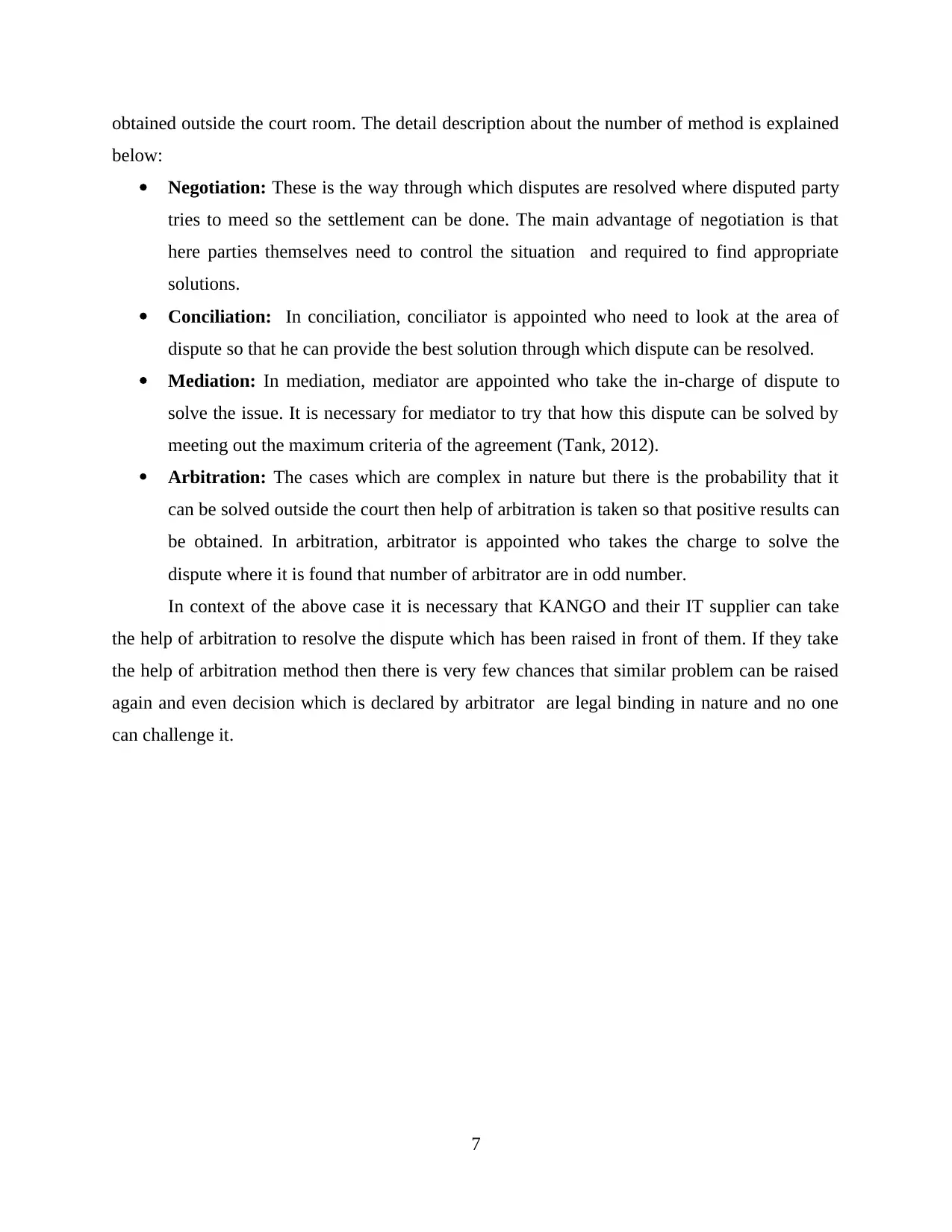
obtained outside the court room. The detail description about the number of method is explained
below:
Negotiation: These is the way through which disputes are resolved where disputed party
tries to meed so the settlement can be done. The main advantage of negotiation is that
here parties themselves need to control the situation and required to find appropriate
solutions.
Conciliation: In conciliation, conciliator is appointed who need to look at the area of
dispute so that he can provide the best solution through which dispute can be resolved.
Mediation: In mediation, mediator are appointed who take the in-charge of dispute to
solve the issue. It is necessary for mediator to try that how this dispute can be solved by
meeting out the maximum criteria of the agreement (Tank, 2012).
Arbitration: The cases which are complex in nature but there is the probability that it
can be solved outside the court then help of arbitration is taken so that positive results can
be obtained. In arbitration, arbitrator is appointed who takes the charge to solve the
dispute where it is found that number of arbitrator are in odd number.
In context of the above case it is necessary that KANGO and their IT supplier can take
the help of arbitration to resolve the dispute which has been raised in front of them. If they take
the help of arbitration method then there is very few chances that similar problem can be raised
again and even decision which is declared by arbitrator are legal binding in nature and no one
can challenge it.
7
below:
Negotiation: These is the way through which disputes are resolved where disputed party
tries to meed so the settlement can be done. The main advantage of negotiation is that
here parties themselves need to control the situation and required to find appropriate
solutions.
Conciliation: In conciliation, conciliator is appointed who need to look at the area of
dispute so that he can provide the best solution through which dispute can be resolved.
Mediation: In mediation, mediator are appointed who take the in-charge of dispute to
solve the issue. It is necessary for mediator to try that how this dispute can be solved by
meeting out the maximum criteria of the agreement (Tank, 2012).
Arbitration: The cases which are complex in nature but there is the probability that it
can be solved outside the court then help of arbitration is taken so that positive results can
be obtained. In arbitration, arbitrator is appointed who takes the charge to solve the
dispute where it is found that number of arbitrator are in odd number.
In context of the above case it is necessary that KANGO and their IT supplier can take
the help of arbitration to resolve the dispute which has been raised in front of them. If they take
the help of arbitration method then there is very few chances that similar problem can be raised
again and even decision which is declared by arbitrator are legal binding in nature and no one
can challenge it.
7
⊘ This is a preview!⊘
Do you want full access?
Subscribe today to unlock all pages.

Trusted by 1+ million students worldwide
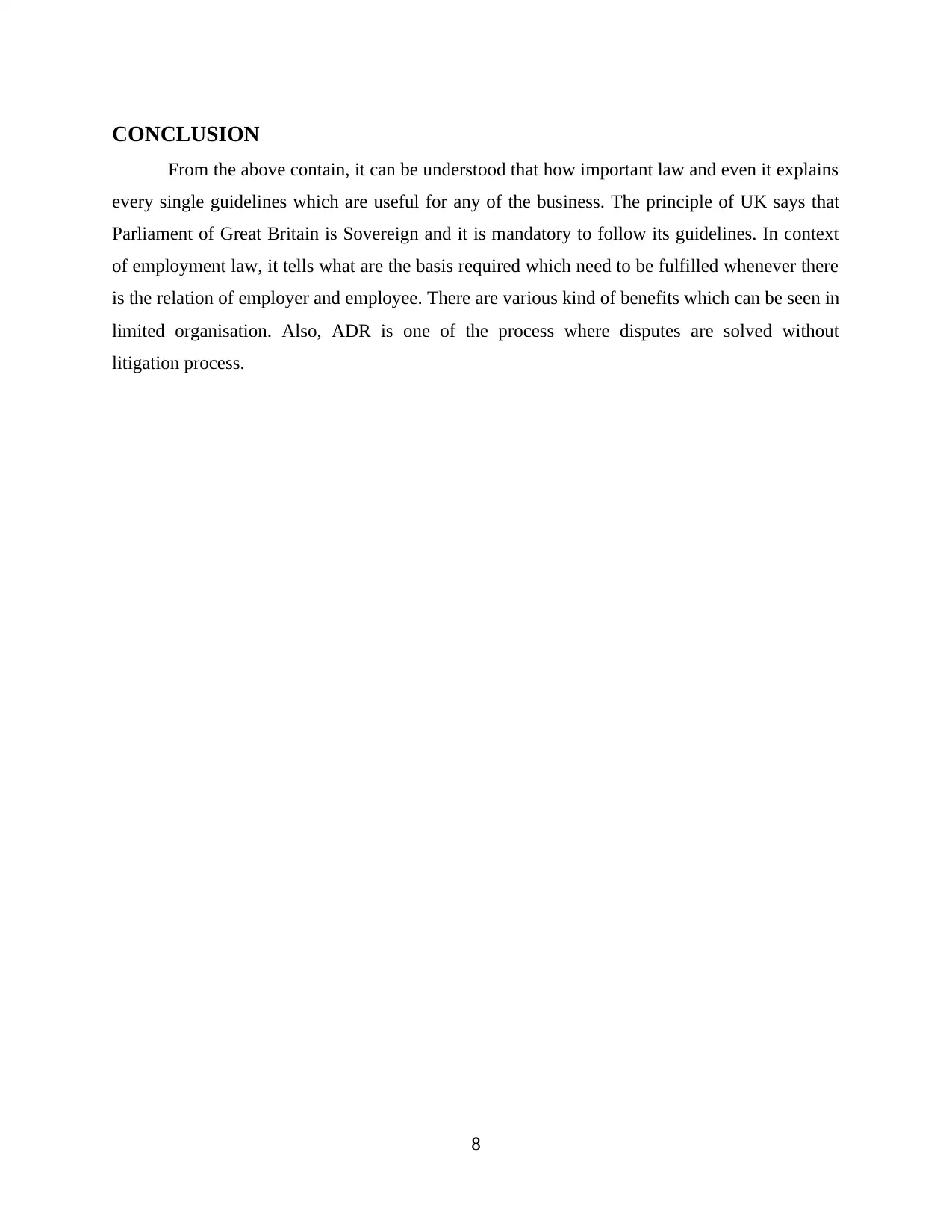
CONCLUSION
From the above contain, it can be understood that how important law and even it explains
every single guidelines which are useful for any of the business. The principle of UK says that
Parliament of Great Britain is Sovereign and it is mandatory to follow its guidelines. In context
of employment law, it tells what are the basis required which need to be fulfilled whenever there
is the relation of employer and employee. There are various kind of benefits which can be seen in
limited organisation. Also, ADR is one of the process where disputes are solved without
litigation process.
8
From the above contain, it can be understood that how important law and even it explains
every single guidelines which are useful for any of the business. The principle of UK says that
Parliament of Great Britain is Sovereign and it is mandatory to follow its guidelines. In context
of employment law, it tells what are the basis required which need to be fulfilled whenever there
is the relation of employer and employee. There are various kind of benefits which can be seen in
limited organisation. Also, ADR is one of the process where disputes are solved without
litigation process.
8
Paraphrase This Document
Need a fresh take? Get an instant paraphrase of this document with our AI Paraphraser
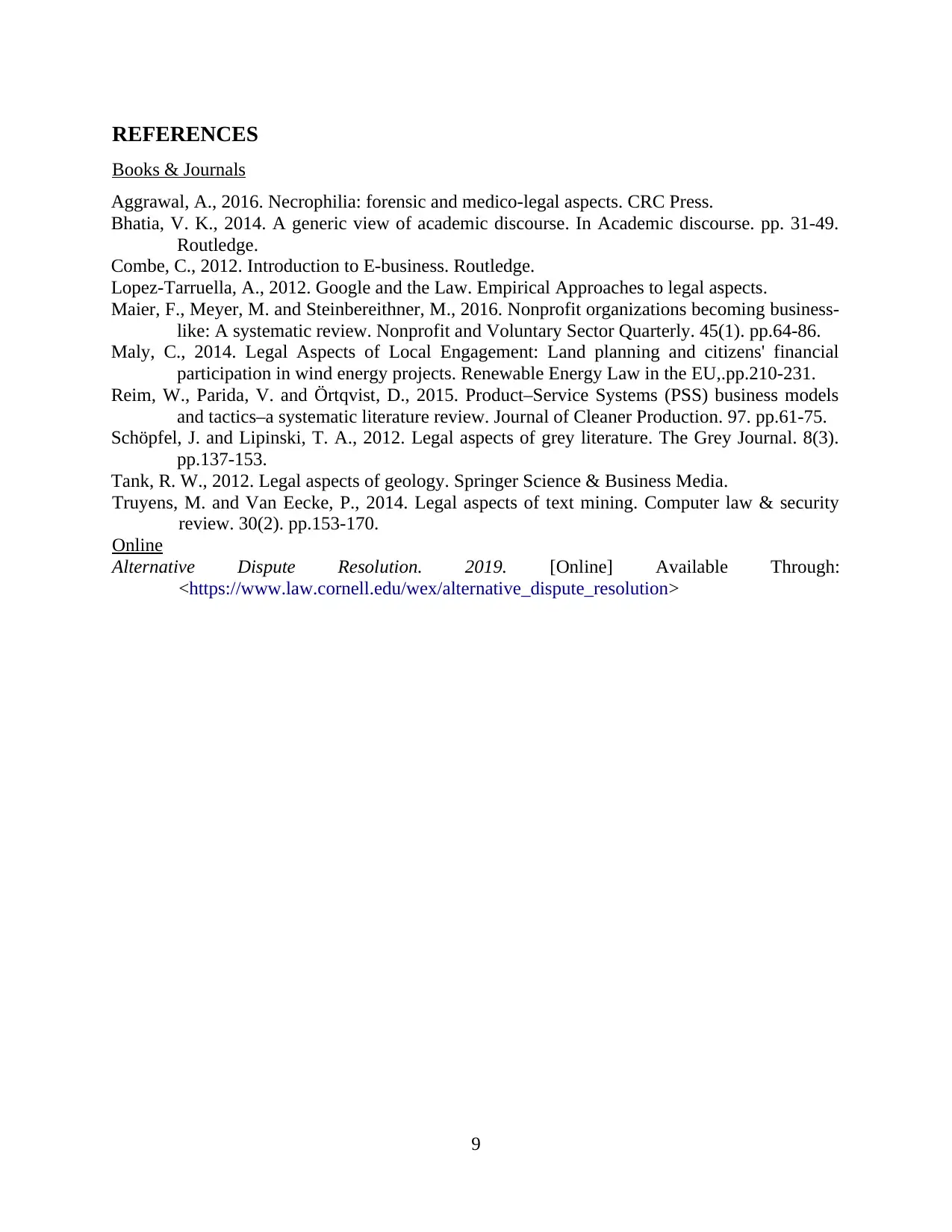
REFERENCES
Books & Journals
Aggrawal, A., 2016. Necrophilia: forensic and medico-legal aspects. CRC Press.
Bhatia, V. K., 2014. A generic view of academic discourse. In Academic discourse. pp. 31-49.
Routledge.
Combe, C., 2012. Introduction to E-business. Routledge.
Lopez-Tarruella, A., 2012. Google and the Law. Empirical Approaches to legal aspects.
Maier, F., Meyer, M. and Steinbereithner, M., 2016. Nonprofit organizations becoming business-
like: A systematic review. Nonprofit and Voluntary Sector Quarterly. 45(1). pp.64-86.
Maly, C., 2014. Legal Aspects of Local Engagement: Land planning and citizens' financial
participation in wind energy projects. Renewable Energy Law in the EU,.pp.210-231.
Reim, W., Parida, V. and Örtqvist, D., 2015. Product–Service Systems (PSS) business models
and tactics–a systematic literature review. Journal of Cleaner Production. 97. pp.61-75.
Schöpfel, J. and Lipinski, T. A., 2012. Legal aspects of grey literature. The Grey Journal. 8(3).
pp.137-153.
Tank, R. W., 2012. Legal aspects of geology. Springer Science & Business Media.
Truyens, M. and Van Eecke, P., 2014. Legal aspects of text mining. Computer law & security
review. 30(2). pp.153-170.
Online
Alternative Dispute Resolution. 2019. [Online] Available Through:
<https://www.law.cornell.edu/wex/alternative_dispute_resolution>
9
Books & Journals
Aggrawal, A., 2016. Necrophilia: forensic and medico-legal aspects. CRC Press.
Bhatia, V. K., 2014. A generic view of academic discourse. In Academic discourse. pp. 31-49.
Routledge.
Combe, C., 2012. Introduction to E-business. Routledge.
Lopez-Tarruella, A., 2012. Google and the Law. Empirical Approaches to legal aspects.
Maier, F., Meyer, M. and Steinbereithner, M., 2016. Nonprofit organizations becoming business-
like: A systematic review. Nonprofit and Voluntary Sector Quarterly. 45(1). pp.64-86.
Maly, C., 2014. Legal Aspects of Local Engagement: Land planning and citizens' financial
participation in wind energy projects. Renewable Energy Law in the EU,.pp.210-231.
Reim, W., Parida, V. and Örtqvist, D., 2015. Product–Service Systems (PSS) business models
and tactics–a systematic literature review. Journal of Cleaner Production. 97. pp.61-75.
Schöpfel, J. and Lipinski, T. A., 2012. Legal aspects of grey literature. The Grey Journal. 8(3).
pp.137-153.
Tank, R. W., 2012. Legal aspects of geology. Springer Science & Business Media.
Truyens, M. and Van Eecke, P., 2014. Legal aspects of text mining. Computer law & security
review. 30(2). pp.153-170.
Online
Alternative Dispute Resolution. 2019. [Online] Available Through:
<https://www.law.cornell.edu/wex/alternative_dispute_resolution>
9
1 out of 11
Related Documents
Your All-in-One AI-Powered Toolkit for Academic Success.
+13062052269
info@desklib.com
Available 24*7 on WhatsApp / Email
![[object Object]](/_next/static/media/star-bottom.7253800d.svg)
Unlock your academic potential
Copyright © 2020–2025 A2Z Services. All Rights Reserved. Developed and managed by ZUCOL.




